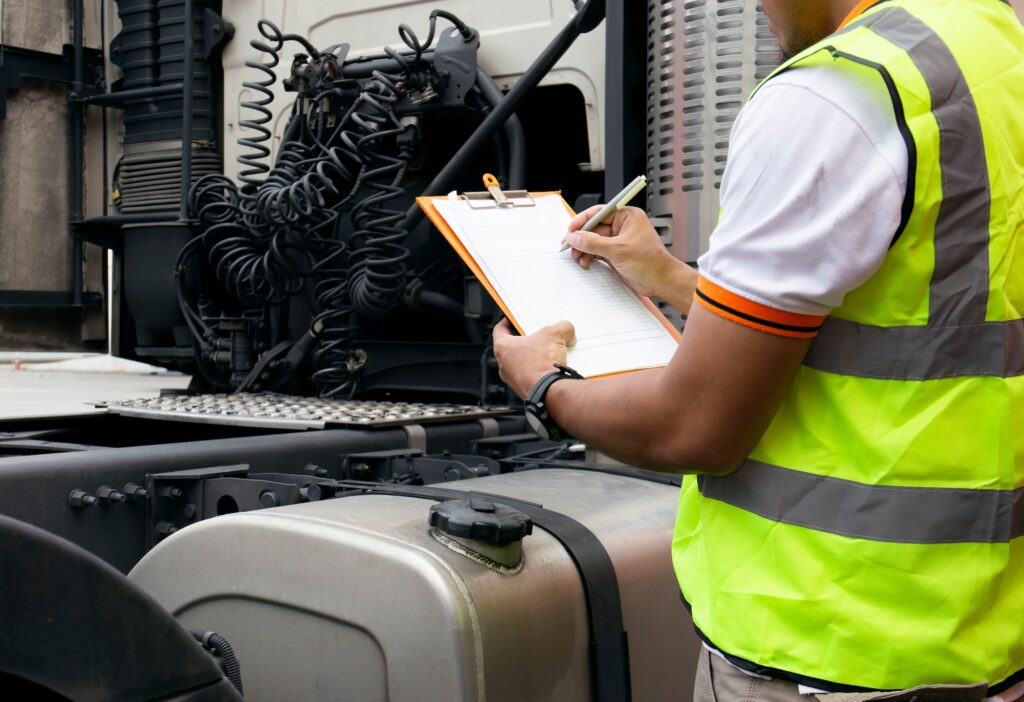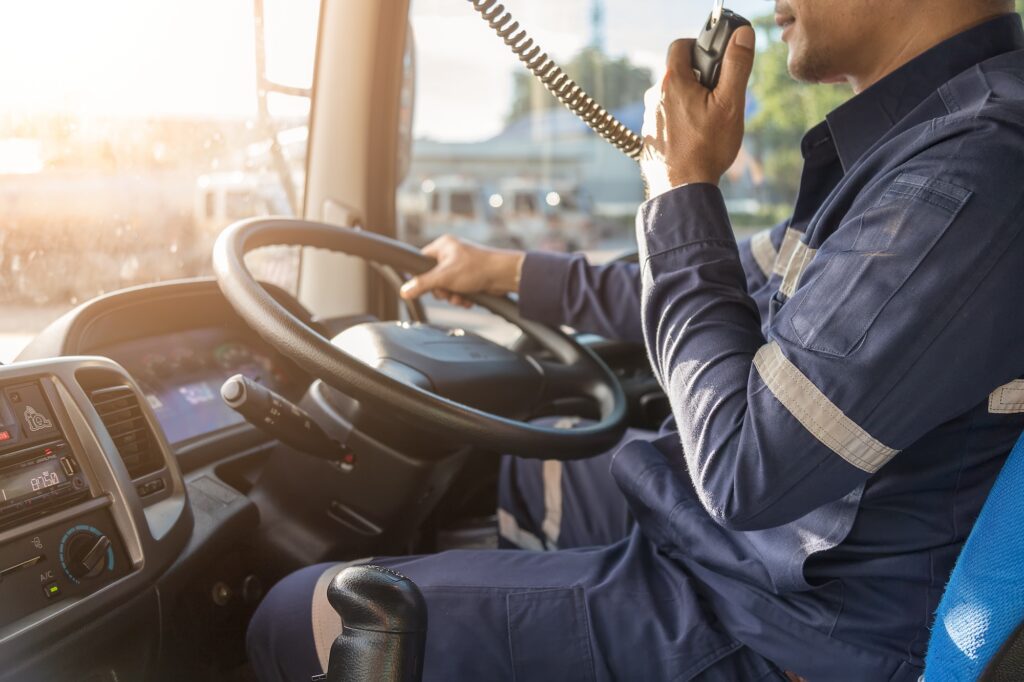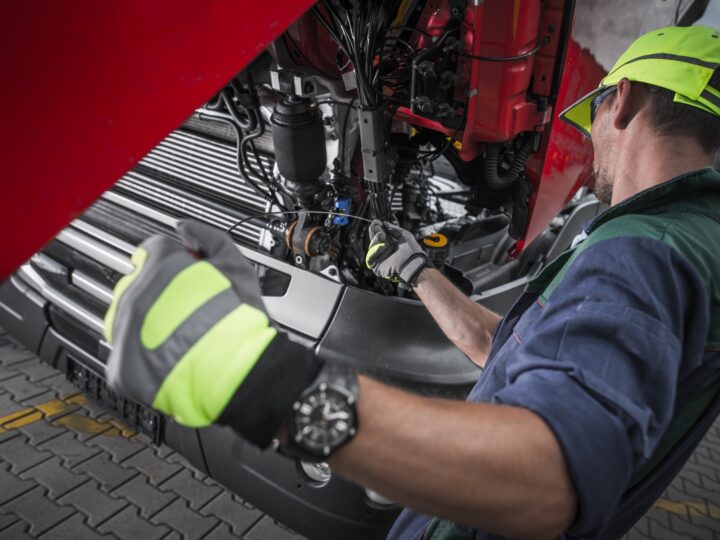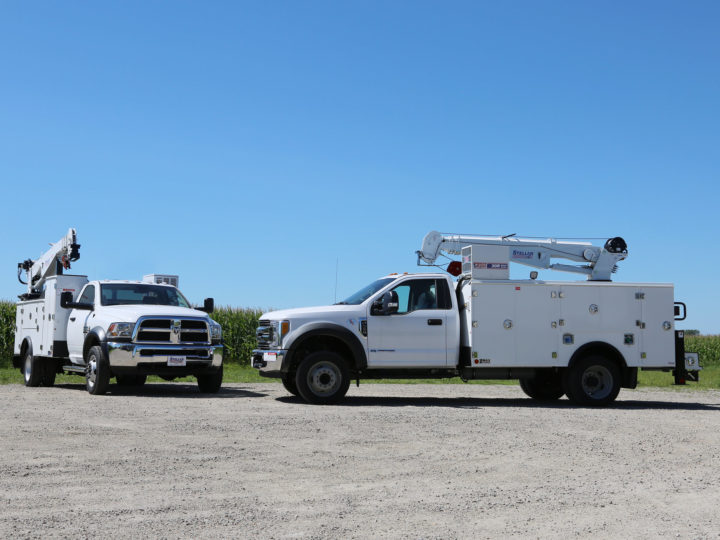

If truck safety isn’t already at the top of your priority list, now’s the time to make it your number one focus.
Why? Because every time a driver turns the ignition key, they’re not just starting a truck; they’re taking responsibility for a vehicle that, without the proper safety measures, could be involved in a devastating accident.
Did you know that in 2021, the National Highway Traffic Safety Administration (NHTSA) reported traffic deaths involving large trucks reached a 16-year high, with over 3,700 fatalities? That’s a staggering 13% increase from the previous year. These aren’t just numbers; they represent lives, families, and communities impacted by road tragedies.
This alarming trend serves as a wake-up call for the trucking industry. It’s a clear signal that we must prioritize and innovate in safety technologies and practices to make our roads—and workplaces—safer for everyone.
But how do we move beyond merely meeting minimum standards to leading by example? How do we harness the best tools, tech, and tactics available to safeguard our work trucks, our teams, and the public at large?
This blog post aims to answer these questions. From essential safety checklists to the latest innovations in truck technology, we’ll cover all the bases to help you keep your work trucks, your team, and the roads as safe as possible.
Why Work Truck Safety Can’t Take a Backseat
Truck safety must be more than a checklist item—it needs to be the foundation of your fleet culture. Here’s why doubling down on truck safety is non-negotiable:
- Protecting Lives: Every statistic represents a life—a driver, a pedestrian, or a passenger. The human cost of accidents is immeasurable, emphasizing the need for rigorous safety measures.
- Workplace and Job Site Safety: Trucks operate in diverse environments, each with its own hazards. Adapting safety practices to these settings mitigates risks significantly.
- Economic Sense: The financial implications of truck accidents are staggering, highlighting the economic rationale behind investing in safety measures. According to the Federal Motor Carrier Safety Administration (FMCSA), the average cost of a large truck crash involving a fatality is approximately $3.6 million per crash. Crashes resulting in injuries present almost $200,000 in costs per incident, while the average cost across all large truck crashes stands at about $91,000 per crash. These figures underscore the significant economic benefit of proactive safety investments, not just in terms of cost avoidance but as a critical component of operational sustainability and financial health.
- Brand Reputation: In an era where information travels faster than ever, a company’s reputation can be significantly impacted by its safety record. Incidents involving driver behavior and safety can influence consumer perceptions and decisions, making it imperative for brands to maintain a strong commitment to safety to preserve trust and loyalty among their customer base.
- Legal and Regulatory Compliance: The regulatory landscape for commercial trucking is complex. Staying ahead of regulations ensures smooth operations and demonstrates your commitment to safety and compliance as core values.
With all of this in mind, there’s no debating that truck safety should be a priority for all drivers and fleet managers. But what actions can be taken to improve truck safety?
Top Accessories for Improved Commercial Truck Safety
One practical way to improve commercial truck safety is to invest in accessories designed to keep your team and vehicles safe and secure— both on the road and on the job.
High-Visibility Accessories: Reflective tape and LED warning lights might seem like small additions, but they can be major lifesavers. The use of high-visibility markings on trucks has been endorsed by various safety organizations, acknowledging their role in preventing accidents by enhancing the visibility of vehicles, especially in low-light conditions. For example, FMCSA recommends the use of reflective tape to outline the sides and rear of trailers, improving visibility for other road users.
Advanced Visibility Systems: The installation of rearview cameras can lead to a 17% reduction in backing crash rates, a significant statistic that highlights the cameras’ role in enhancing driver awareness and preventing collisions. Additionally, systems like blind spot detection not only complement the driver’s field of view but also actively contribute to safer lane changes and maneuvers, crucial in preventing side-swipe accidents.
Load Securement Tools: Properly securing cargo is not just about avoiding fines; it’s about preventing accidents caused by shifting loads, which can lead to loss of control. The Department of Transportation (DOT) provides comprehensive guidelines on cargo securement, emphasizing the importance of using the right tools and techniques to keep loads stable and secure during transit.
Emergency Preparedness Kits: A well-stocked first aid kit and emergency roadside kit are essential components of a proactive safety approach. These kits ensure that drivers can respond effectively to injuries or breakdowns, potentially saving lives and reducing the severity of incidents before professional help arrives.
Technology Integration: Telematics and Electronic Logging Devices (ELDs) do more than just track vehicle and driver performance. They provide actionable insights that can lead to improved safety outcomes. For instance, telematics can alert fleet managers to erratic driving behavior or maintenance needs, allowing for timely interventions that can prevent accidents.
Daily Truck Safety Checklist for Drivers
A daily safety checklist can go a long way in staying on top of truck maintenance and preventing potential hazards. Here’s an example of a thorough truck safety checklist that can be used before your drivers hit the road:
Vehicle Inspection
Tires: Check for proper inflation, wear, and any visible damage that could lead to blowouts or flats.
Lights: Ensure all headlights, tail lights, brake lights, and indicators are functioning correctly to maintain visibility.
Brakes: Test the brake system for responsiveness and any unusual noises or vibrations that could indicate wear or failure.
Mirrors and Windows: Clean and adjust all mirrors and ensure windows are clear for optimal visibility.
Fluid Levels: Check oil, coolant, brake, and windshield washer fluid levels to prevent mechanical failures.
Load and Cargo Securement
Cargo: Verify that the cargo is properly secured with the appropriate tools and equipment, as a shifting load can dramatically affect a truck’s stability and control.
Weight: Ensure that the weight distribution is even and does not exceed the vehicle’s maximum carrying capacity.
Emergency and Safety Gear
First Aid: Confirm that the first aid kit is fully stocked and that fire extinguishers are accessible and in good working condition.
Roadside Equipment: Check that all emergency roadside equipment, such as warning triangles and high-visibility vests, are onboard and easily reachable.
Documentation
Vehicle Registration: Ensure that all necessary documentation, including the vehicle’s registration, insurance, and any required permits, are present and up to date.
Communication Devices
Communication: Test communication devices to ensure they are in working order, enabling the driver to contact dispatch or emergency services if needed.
Using a daily checklist like this one not only promotes safety but also reinforces a culture of accountability and due diligence among drivers. It’s a proactive approach to identifying and addressing risks before they can escalate into more significant issues.
Implementing Fleet Safety Management
The next crucial component in enhancing truck safety is implementing robust fleet safety management practices. This involves integrating the use of advanced tools, technologies, and strategies within a comprehensive safety program to ensure the well-being of drivers and the public. Think of your fleet safety program as a safety net that catches issues before they can escalate.
For effective fleet safety management, consider the following strategies, illustrated by real-world examples from leading companies:
Regulatory Mastery
Stay abreast of the latest regulations and safety standards by fostering partnerships with safety experts and regulatory bodies. This ensures your fleet not only meets but exceeds compliance requirements, safeguarding the well-being of drivers and the public. CFI (Contract Freighters, Inc.) exemplifies this through their comprehensive safety measures and advanced driver training programs, significantly reducing accidents and enhancing fleet safety.
Safety Meetings & Training
Regularly scheduled safety meetings and comprehensive driver training programs are crucial. These sessions should cover defensive driving, proper cargo handling, and up-to-date compliance regulations, reinforcing a culture of safety and continuous learning. DTE Energy integrates technology with safety training, using vehicle telematics and regular safety meetings to reduce incidents and promote a safety-first mindset among drivers.
Incentivizing Safety and Compliance
A reward system that acknowledges safe driving and strict adherence to safety regulations motivates your team to maintain high safety standards. Recognizing these achievements can significantly enhance morale and encourage a collective commitment to safety. Frito-Lay has developed a comprehensive fleet safety program that includes rigorous driver training and the use of dash cams to ensure compliance and safe driving practices, serving as a model for incentivizing safety.
Technology as a Compliance Ally
Utilize telematics and other safety technologies not just for monitoring but as tools for ensuring compliance with Hours of Service regulations, vehicle maintenance schedules, and more. Real-time data allows for immediate adjustments, ensuring your fleet operates within legal and safety parameters. Ford Motor Company and UPS are leaders in this area, with Ford integrating advanced safety technologies into their fleet vehicles and UPS using the ORION system to optimize routes and reduce risky driving behaviors.
Open Channels for Safety Dialogue
Establish a transparent system for reporting safety concerns and compliance issues. This empowers your team to take ownership of safety, fostering a trust-based environment where everyone feels responsible for maintaining high safety standards. Companies like UPS have excelled by creating an environment where safety is everyone’s responsibility, thanks to open communication and advanced routing technologies.
Iterative Improvement and Adaptation
Regularly review and refine your safety and compliance strategies based on feedback, technological advancements, and regulatory changes. This dynamic approach ensures your fleet’s safety management practices remain at the forefront of industry standards, exemplifying your commitment to excellence and continuous improvement.
By looking to these companies as benchmarks, your organization can gain insights into the practical application of fleet safety management strategies. Creating a culture where safety comes first means everyone is looking out, not just for themselves, but for each other too. Implementing these strategies effectively can transform your fleet safety management from a concept into a lived reality, ensuring the wellbeing of your drivers and the public at large.
Proactive Truck Safety Tips for Every Journey
Ensuring truck safety on every trip demands a detailed and proactive approach. Here’s how to make every journey safer:
Weather Awareness
Always check the weather forecast before departure. Adjust your driving style to accommodate rain, snow, ice, or high winds. In severe conditions, don’t hesitate to delay trips.
Thorough Pre-Trip Inspections
Conduct comprehensive checks focusing on tires (look for wear, damage, and ensure proper inflation), brakes (test for responsiveness), lights and indicators (confirm all are operational), and mirrors and windows (should be clean for clear visibility). Don’t forget to check fluid levels, including oil, coolant, and brake fluid, to prevent mechanical failures.
Fatigue Management
Understand the signs of fatigue and take regular breaks. Use the 2-hour rule: stop for at least 15 minutes every 2 hours or 100 miles. Stay hydrated and eat light meals to maintain alertness.
Load Securement
Ensure cargo is evenly distributed and securely fastened. Regularly check securement devices for wear and replace as necessary. For special or oversized loads, follow specific guidelines to ensure stability.
Emergency Preparedness
Equip your truck with a well-stocked first aid kit, fire extinguishers, and emergency roadside equipment, including warning triangles and high-visibility vests. Familiarize yourself with the use of each item.
Adaptive Driving Practices
Maintain a safe following distance, anticipate the actions of other road users, and use defensive driving techniques. Be particularly cautious in construction zones and urban areas where pedestrians and cyclists are present.
Implementing these detailed tips not only enhances safety but also contributes to a more responsible and professional driving culture.
Building a Culture of Continuous Safety in Your Fleet
To take it a step further and create a continuous safety culture within your fleet, you need to integrate safety into every aspect of your operations. It’s about creating an environment where safety isn’t just policy, but a core value that guides decisions and actions at all levels.
Encourage Open Communication
Encourage open dialogue about safety concerns. Make it easy and fear-free for team members to report issues or suggest improvements.
Continuous Learning and Development
Offer ongoing education and training opportunities that not only focus on compliance but also on best practices and innovative safety solutions. Learning should be continuous, with regular refreshers and updates to address new challenges and technologies.
Lead by Example
Leadership should exemplify the safety culture, demonstrating commitment through actions, not just words. When leaders prioritize safety in their daily routines, it sets a powerful example for the entire team.
Empowerment and Accountability
Empower employees to take proactive steps towards safety and hold them accountable for their actions. This includes recognizing and rewarding safe behavior while also addressing unsafe practices with constructive feedback and corrective actions.
Incorporate Safety into Daily Operations
Make safety a key component of daily check-ins, meetings, and briefings. This keeps safety top of mind and reinforces its importance in day-to-day activities.
Utilize Technology
Leverage technology not just to monitor and improve safety but also to facilitate communication, training, and engagement around safety topics. From telematics to safety apps, technology can provide valuable support in building a safety-centric culture.
Review and Adapt
Regularly review safety incidents and near misses. Use these as learning opportunities to adapt and improve your safety strategies. This iterative process ensures your safety culture remains dynamic and responsive to new insights and industry trends.
Building a culture of continuous safety is an ongoing journey, one that requires commitment, collaboration, and a willingness to evolve. By embedding safety into the fabric of your fleet operations, you create a resilient and responsible organization that values the well-being of its team and the public.
Leveraging the Latest Technology for Fleet Safety
Leveraging the latest technology for fleet safety is essential for staying ahead in today’s fast-paced world. It’s not just about keeping track of vehicles and drivers, but actively using tech to prevent accidents and enhance safety. This includes adopting advanced driver assistance systems (ADAS) like lane-keeping assist, automatic emergency braking, and fatigue monitoring systems. It also means utilizing telematics for real-time data on driving habits, vehicle health, and more.
Emerging Technologies Transforming Fleet Safety:
Predictive Analytics with AI and Machine Learning
Utilizing AI and machine learning for predictive analytics marks a significant leap forward. By analyzing telematics data, these technologies can forecast potential safety issues, enabling fleet managers to intervene before incidents occur, thereby enhancing preemptive safety measures.
V2X Communication for Connected Vehicles
The advent of Vehicle-to-Everything (V2X) communication allows vehicles to interact with each other and with road infrastructure. This innovation boosts situational awareness and minimizes collisions through real-time alerts about road conditions, traffic, and nearby emergency vehicles, paving the way for a more interconnected and safer driving environment.
Advanced Driver Monitoring Systems (DMS)
Modern DMS technologies extend beyond fatigue detection to identify signs of distraction, such as phone usage or lack of attention, alerting drivers to maintain focus. By assessing eye movement and posture, these systems evaluate alertness levels, significantly reducing the risk of accidents due to inattention.
Semi-Automated and Autonomous Vehicles (AVs)
The integration of semi-automated driving features, including adaptive cruise control, lane centering, and self-parking, reduces driver strain and enhances safety. The progression towards fully autonomous fleets represents a transformative shift, with the potential to drastically reduce accidents by eliminating human error.
Blockchain for Security and Transparency
Implementing blockchain technology ensures the secure and transparent documentation of vehicle maintenance records, driver certifications, and safety inspections. This innovation fosters a higher degree of compliance and accountability, reinforcing the integrity of fleet operations.
Augmented Reality (AR) in Training and Maintenance
AR technology offers immersive training experiences, simulating diverse road scenarios and hazards in a controlled environment. For maintenance, AR aids technicians by overlaying digital information on physical components, streamlining repairs and ensuring vehicles are safely maintained.
Recent studies underscore the effectiveness of these technologies in preventing accidents. For instance, Forward Collision Warning (FCW) and Automatic Emergency Braking (AEB) systems have been shown to be effective countermeasures for crashes in which large trucks rear-end other vehicles. The adoption of FCW and AEB is expected to significantly improve large truck safety, highlighting the critical role of technology in advancing fleet safety measures.
Embracing these technological advancements transforms fleet safety management into a dynamic, responsive component of your operations, ensuring that safety not only keeps pace with innovation but also sets new benchmarks for the industry.
Boost Work Truck Safety with Truck Customization from PTC
Boosting work truck safety with truck customization from PTC is the final, crucial step in ensuring your fleet’s security. By choosing quality parts, accessories, and relying on professional installation, you can tailor your vehicles to meet specific safety needs. Whether it’s enhancing visibility with custom lighting solutions, improving driver comfort and control, or adding advanced safety technologies, customization allows for a tailored approach to safety, particularly for unique industry demands.
We urge you to embrace a comprehensive safety strategy—starting with daily checks and extending through to cutting-edge technology and customization. Contact our experts at Pacific Truck Colors for professional advice and truck customization services for improved safety.










